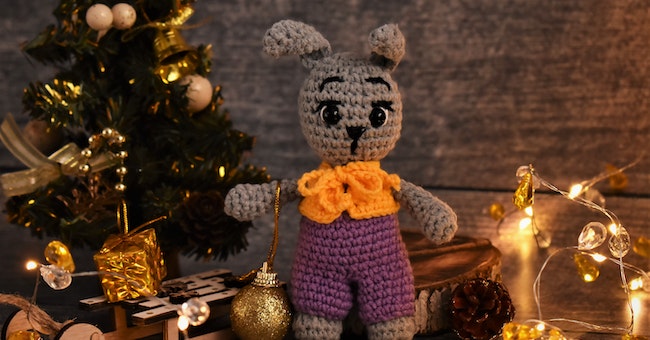How to Start Knitting for Beginners?

Introduction
Knitting has gained significant popularity in recent years as a creative and fulfilling craft. People of all ages and backgrounds are discovering the joy of knitting and the endless possibilities it offers for self-expression and personal satisfaction.
Knitting, in its essence, is not only an enjoyable pastime; it also provides numerous benefits. It promotes relaxation, enhances focus and concentration, and stimulates cognitive function. Furthermore, knitting offers a sense of accomplishment as you create beautiful and functional items with your own hands. Whether you want to knit cozy scarves, stylish sweaters, or intricate blankets, knitting allows you to unleash your creativity and produce unique pieces that reflect your personal style. In today's article, we will rectify the common misconception about knitting, illustrate some of its unexpected benefits for our physical and mental health, and finally explore valuable resources to master such a practical skill.
Reasons Why Knitting is Perceived as Difficult
Knitting is a craft that is often perceived as difficult, especially for beginners. However, many of the reasons behind this perception are rooted in misconceptions and misunderstandings. Let's explore some common reasons why knitting is seen as challenging and address them one by one.
Common Misconceptions about Knitting
Misconception 1: Knitting requires exceptional artistic talent
One of the main reasons knitting is seen as difficult is the misconception that it requires exceptional artistic talent. Many people believe that knitting is only for those with a natural creative flair or advanced artistic skills. However, this is far from the truth. While knitting does involve creativity, it is a skill that can be learned and improved with practice. You don't need to be an artist to start knitting. With the right guidance and resources, anyone can become proficient in knitting.
Misconception 2: Knitting is time-consuming
Another common misconception is that knitting is a time-consuming activity. Some people believe that knitting requires hours of uninterrupted focus and dedication, making it impractical for those with busy schedules. While knitting does take time, it's important to note that you can tailor your knitting projects to fit your available time. You can start with small, simple projects that can be completed relatively quickly. As you gain more experience and confidence, you can take on more complex and time-intensive projects.
Misconception 3: Knitting is expensive
There is a perception that knitting is an expensive hobby, with the cost of materials and supplies being prohibitive. While it's true that high-end yarns and knitting accessories can be costly, there are plenty of affordable options available for beginners. You can find budget-friendly yarns and basic knitting needles to get started. Additionally, as you develop your skills, you can gradually invest in higher-quality materials. Knitting doesn't have to break the bank, and with careful planning, you can create beautiful projects within your budget.
Addressing the Challenges Beginners May Face
Challenge 1: Learning basic knitting techniques
For beginners, learning the basic knitting techniques can seem overwhelming. Terms like casting on, knitting, purling, and binding off may sound confusing at first. However, with proper guidance and practice, these techniques can be mastered. There are numerous resources available, including books, online tutorials, and knitting classes, that provide step-by-step instructions and demonstrations. Starting with simple projects and gradually progressing to more complex ones will help you build confidence and improve your skills.
Challenge 2: Fixing mistakes and unraveling work
Making mistakes is a normal part of the knitting process, and unraveling your work to correct them can be disheartening. However, it's important to remember that even experienced knitters make mistakes. The key is to approach mistakes as learning opportunities rather than failures. Understanding how to identify and fix common knitting mistakes, such as dropped stitches or incorrect stitch counts, will greatly enhance your knitting journey. With practice, you'll become more adept at troubleshooting and fixing errors, ensuring your projects turn out beautifully.
Challenge 3: Maintaining consistent tension
Achieving consistent tension in your knitting, where all stitches are the same size, can be challenging for beginners. Uneven tension can result in lopsided or misshapen projects. However, this is a skill that improves with practice. Paying attention to your hand position, grip, and needle size can help you maintain more even tension. As you become more familiar with the process, your tension will naturally become more consistent. Remember, knitting is a journey, and embracing the learning process is part of the experience.
By debunking misconceptions and addressing the challenges beginners may face, we hope to demystify knitting and encourage aspiring knitters to embark on this rewarding craft.
Anyone Can Learn to Knit
One of the greatest myths surrounding knitting is the belief that it is an exclusive craft meant for a select few. This notion often discourages individuals from attempting to learn, as they perceive it as something reserved for experienced or highly skilled individuals. However, it is important to break this myth and emphasize that knitting is accessible to everyone. Knitting is not limited to a specific age group, gender, or skill level. Anyone, regardless of their background or prior experience, can learn to knit. It is a versatile craft that accommodates beginners and advanced practitioners alike. With determination, patience, and the right resources, anyone can develop the skills necessary to create beautiful knitted items.
Knitting is a wonderfully inclusive activity that brings people together from various walks of life. It transcends cultural boundaries and connects individuals through a shared love for creating with yarn and needles. Regardless of your age, gender, or background, you can join the knitting community and be part of a supportive and diverse network of individuals who appreciate the art of knitting.
Knitting circles provide opportunities to meet fellow knitters, exchange ideas, and learn from one another. These gatherings foster a sense of community and provide a space where beginners can receive guidance and support from more experienced knitters. Additionally, knitting charities and organizations often welcome volunteers of all skill levels to contribute their time and talent to creating knitted items for those in need. Knitting truly embraces inclusivity and offers a platform for people to connect and share their passion for the craft.
The Benefits of Knitting
The Therapeutic Effects of Knitting
Knitting has been recognized for its numerous therapeutic benefits, making it more than just a creative hobby. Engaging in knitting can have a calming effect on the mind and body, promoting relaxation and reducing anxiety. The repetitive and rhythmic motions involved in knitting can induce a meditative state, similar to practicing mindfulness or deep breathing exercises. This focused attention on the task at hand can help alleviate stress and promote a sense of calmness.
Moreover, knitting has been found to improve mental well-being by increasing dopamine and serotonin levels in the brain. These neurotransmitters are associated with positive emotions, pleasure, and overall mood regulation. By engaging in knitting, individuals may experience a boost in their overall mental and emotional well-being.
Reduction of Stress Hormones
In today's fast-paced world, stress has become a common occurrence for many people. The good news is that knitting can act as a natural stress reliever. When you knit, your body releases endorphins, which are known as the "feel-good" hormones. These endorphins help counteract the effects of stress hormones like cortisol, reducing feelings of anxiety and promoting relaxation. Knitting can provide a much-needed escape from the pressures of daily life, allowing you to focus on a soothing and rewarding activity.
Assistance with Addiction Recovery
Knitting has been increasingly recognized as a beneficial tool for individuals recovering from addiction. The rhythmic and repetitive nature of knitting can serve as a healthy distraction and a way to channel energy into a positive and productive activity. Engaging in knitting can provide a sense of purpose, boost self-esteem, and help individuals develop a new focus outside of their addictive behaviors. It can also serve as a means of stress relief during challenging moments, providing a healthier coping mechanism.
Potential Prevention of Low-level Memory Loss
Studies have shown that engaging in mentally stimulating activities like knitting may help prevent or slow down low-level memory loss associated with aging. Knitting requires concentration, pattern recognition, and problem-solving skills, which can help keep the brain active and engaged. By regularly practicing knitting, you can exercise your cognitive abilities and potentially enhance your memory and overall brain function.
Channels for Learning to Knit
Traditional Learning Methods
Local knitting classes near me:
Local knitting classes are an excellent way to learn knitting in a structured and supportive environment. Many community centers, yarn shops, and craft stores offer knitting classes for beginners. These classes are typically led by experienced instructors who provide step-by-step guidance, demonstrate techniques, and offer hands-on assistance. Learning in a classroom setting allows for real-time interaction and personalized feedback, making it an ideal option for those who prefer in-person instruction.
Knitting books and tutorials:
Knitting books and tutorials have long been valuable resources for aspiring knitters. They provide comprehensive instructions, illustrations, and patterns that cater to various skill levels. Beginners can find books specifically designed to teach the basics of knitting, covering everything from fundamental stitches to more advanced techniques. These resources often include projects with clear instructions to help learners practice their newfound skills. Additionally, online tutorials and websites offer a wealth of knitting information and step-by-step guides, making it convenient to access learning materials from the comfort of your home.
Online Resources and Platforms
Knitting websites and forums:
The internet has revolutionized the way people learn and connect, and knitting is no exception. Numerous knitting websites and online forums provide a wealth of information, patterns, and support for knitters of all levels. These platforms offer a space to seek advice, share experiences, and participate in knitting communities. Whether you have questions about a particular stitch, need pattern recommendations, or simply want to engage with fellow knitting enthusiasts, these online resources are invaluable for expanding your knowledge and skills.
Video tutorials:
Video tutorials on platforms like YouTube have become increasingly popular for learning knitting. With a vast array of knitting channels available, beginners can find instructional videos that cater to their specific needs. These videos often feature experienced knitters demonstrating techniques, explaining stitch patterns, and providing helpful tips. Whether you are interested in basic steps of knitting or rather advanced skills, AZClass offers a wide selection of courses designed to help you master this skill and start bringing your ideas to life.
In the Knitting Online Courses Catalog, we have gathered useful courses for you. In particular, here we have a couple of courses that are definitely worth your attention.
FANTASTIC Very Beautiful Crochet Pattern Knitting Online Tutorial for beginners
"FANTASTIC Very Beautiful Crochet Pattern Knitting Online Tutorial for beginners" is an online course available on YouTube, presented by Knitting Love. This course aims to teach beginners a variety of stunning crochet patterns, including baby vests, blankets, bags, jackets, cardigans, bandannas, hair bands, knitted bags, hand knits, and needle knits. It also covers free crochet flower patterns, crochet butterflies, puff flower crochet patterns, easy crochet hearts, crochet roses, crochet circle patterns, free leaf crochet patterns, and offers woolen craft ideas to foster creativity in projects.
Pros of the course:
Diverse Range of Patterns
Step-by-Step Tutorials
Accessible Learning Platform
Creative Project Ideas
Cost-Free Learning
Wonderful Very Very Beautiful Crochet Pattern Knitting Tutorial for beginners
This is an online training course that offers a fantastic opportunity to learn how to create beautiful crochet motif patterns. From baby vests, blankets, cardigans, bags, jackets, and bandannas to hair bands, knitted bags, hand knits, and needle knits, this course covers a wide range of projects. With its clear tips, motivational content, practical advice, beautiful design, and efficient approach, the course equips beginners with the skills and inspiration needed to create stunning crochet patterns.
Pros of the course:
Clear and Helpful Tips
Inspiring and Motivational Content
Practical Information and Advice
Beautiful Design and Cute Crochet
Efficient Work and Bonjour-Friendly
Knitting 101: The Basics for Beginners
The Basics for Beginners is a comprehensive online course offered by Skillshare. This course is designed to teach the fundamentals of knitting, including casting on and off, knit and purl stitches, weaving in ends, and working with different types of yarn. It also covers essential skills such as using a gauge swatch to customize projects and switching colors or adding more yarn. The course provides step-by-step instructional videos to guide learners through each skill. By the end of the course, participants will have knitted a cozy scarf and acquired the basic knowledge to tackle various knitting projects.
Pros of this course:
Wide coverage
Easy to follow
Solid foundation
Conclusion
Contrary to common misconceptions, knitting is a craft that can be easily learned and enjoyed by beginners. With patience, practice, and the right resources, anyone can start their knitting journey and gradually develop their skills. Remember that knitting is a process, and it's perfectly normal to make mistakes along the way. Embrace the simplicity of knitting and enjoy the journey of learning and creating.
To get started with knitting, you need a few basic supplies, including knitting needles and yarn. Learning the fundamental techniques, such as casting on, knitting, purling, and binding off, will provide you with a solid foundation. There are numerous online tutorials, books, and classes available that can guide you through these essential techniques. As you become more comfortable, you can explore more advanced stitches and patterns to expand your repertoire.
Knitting offers a unique sense of accomplishment and satisfaction. The ability to transform a simple strand of yarn into a beautiful, tangible item is truly rewarding. Whether you're knitting a cozy scarf, a soft blanket, or a stylish sweater, the creative possibilities are endless. The process of selecting colors, patterns, and textures allows you to infuse your personal style and creativity into each project. Embrace the joy of creating something with your own hands and revel in the pride that comes with completing a knitting project.
In conclusion, knitting is a versatile and accessible craft that offers numerous benefits for individuals of all ages and backgrounds. It promotes relaxation, reduces stress, supports addiction recovery, and may even have cognitive benefits. So grab your needles, choose your favorite yarn, and embark on a knitting journey filled with creativity, self-expression, and a sense of accomplishment. Happy knitting!





